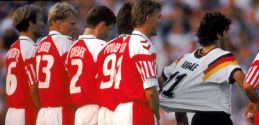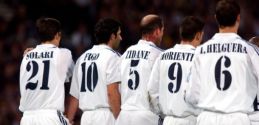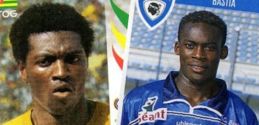 1 comments
1 comments
A guide to the 2011 Copa America: Part Three – The Under-Achievers, Colombia & Peru
Get your readers on as David N knows what he’s talking about and this is the third part of his guide to the Copa America.
COLOMBIA
Colombia has a population of over 46 million people, making it the second most populous country in South America after Brazil. That population is football crazy. There are a half dozen huge clubs from a handful of Colombia’s big cities, contesting the Categoria Primera A twice every year, among them America, Millonarios, Deportivo Cali and Once Caldas, (who won the Copa Libertadores a few years ago) and Colombian players play in all of the major leagues of Europe and South America. Colombia, by rights, should be a big rival to Brazil and Argentina for the bragging rights in their continent.
But they’re not. Instead, after decades of political, social and economic problems, including the huge shadow cast by the thriving drug industry, internal military conflict and the instability caused by groups like FARC, Colombia’s national team underperforms with monotonous consistency. They are never really boring - the story of the great Colombian side of the 1990s reads like a particularly unbelievable soap opera, featuring drug cartels, crazy goalkeepers, death threats to the whole team during a World Cup tournament and the eventual tragic murder of Andres Escobar as part of its narrative. And that truly was a great team, with Carlos Valderrama the beautifully elegant playmaker who kept it all running smoothly surrounded by more unpredictable talents like Faustino Asprilla and the class of Leonel Álvarez and Freddy Rincon.
Their legendary 5-0 defeat of Argentina in Buenos Aires in September 1993 may have slightly flattered them - Argentina had several chances to score at 0-0 - but it came in the middle of a 34 game unbeaten run, and that was accomplished playing stylish, at times almost hypnotic passing football the likes of which Colombia has not seen since. That is partly down to their concerted failure to win anything during that era together with the deep trauma caused by Escobar’s murder. The passing game played by that team went out of favour in Colombia, replaced by a belief in a more physical sort of football. That “spontaneous generation” were never adequately replaced in the national team, and a few too many mediocre players have worn the Colombian shirt in the years since. They did however manage to surprise everybody by winning the Copa America at home in 2001, at a tournament of shocks boycotted by Argentina and the US, in which Honduras eliminated Brazil and Mexico reached the final.
The present Colombia squad would seem to be the most talented in at least a decade and there is an important link to that 90s side in the form of coach Hernan Dario Gomez, who was assistant manager in 1990 and 1994 and took sole charge in 1998. Since then he has changed his tactics considerably, replacing a Valderrama-style enganche with creative, attacking wide midfielders, a formula which brought his Ecuador team qualification for the 2002 World Cup.
The talent of Racing Club’s lanky young playmaker Giovanni Moreno seemed to have convinced Gomez that he could use a more central creator than he had with Ecuador, but Moreno is out with a long-term cruciate injury, and rather than risk using Porto’s thrilling young playmaking prospect James Rodriguez (who is instead playing at the Toulon Tournament, and has guided Colombia to the final) Gomez has once more slightly recalibrated his side.
His recent formation is a 4-1-2-3, with a midfield trio composed of a holding player (either Valenciennes’ Carlos Sanchez or Gustavo Bolivar of Tolima) and two more multi-purpose players who will almost certainly be Fredy Guarin of Porto and Abel Aguilar of Hercules. These two will be under a lot of pressure to create in the absence of Moreno, but Guarin had an incredible season with his club and seems to have dealt with the inconsistency which troubled him in recent years. He also discovered his shooting boots for Porto this season, scoring several stunning long-distance efforts, and his understanding with club-mate Radamel Falcao (top) could be absolutely crucial for Colombia this year.
Falcao has established himself as one of the hottest strikers in European football. Strong, quick, clever in his movement, he puts the ball into the back of the net with stunning consistency. He also seems to be a big game player, although his international record of seven goals in 28 games is far below his capabilities.
He will probably be flanked by two wide attackers, and here Gomez has plenty of options, from the experience of Wigan’s Hugo Rodallega, who usually plays off the left side for his country, to the explosive talent of Dayro Moreno (right), whose goals have just helped Once Caldas to another League Championship in Colombia, and Hertha Berlin’s Adrian Ramos, another player coming off an influential season. Racing Club’s prolific Teo Gutierrez and Chiapas’ Jackson Martinez offer more traditional centre-forward skills, and their presence allows Gomez to change style easily within a game if he needs to.
This is a young Colombia squad, and for that reason a player like captain Mario Yepes is crucial. His 77 caps and 35 years - together with a successful club career including spells at River Plate, PSG, Chievo and currently AC Milan - mean that he is the wise old head and leader commanding the Colombian defence. The younger, more mobile and exciting Cristian Zapata of Udinese is his partner, and a solid back line is based upon that combination.
Colombia are perhaps the darkest of dark horses for this tournament, which is maybe slightly unfair. Anybody who has seen them perform recently will have seen a team with class all over the pitch, playing nice, constructive, attractive passing football. A recent 1-0 defeat to Spain was interesting: Colombia passed and played, matched their illustrious opponents, and made countless chances, which they could not finish off. If they can solve that problem of goals - and Falcao could be the one-man solution - then they will be a threat to any opposition in Argentina.
I love the commentary on this.
PERU
Peruvian football has enjoyed two golden ages: the 1930s, when Peru won the Copa America in 1939, on home soil, and more spectacularly, the 1970s, when the Golden Generation of Cubillas and Sotil qualified for three World Cups and won the 1975 Copa. Since their last qualification in 1982, Peru have endured 27 years of scandal (star players caught going clubbing late at night by tabloids days before important ties and subsequently banned in 2009), tragedy (the 1987 Allianza Lima disaster in which a flight with that clubs squad on board crashed into the Pacific, leaving the entire playing and coaching staff among the 43 dead and depriving Peru of half its national team), corruption (FIFA suspending several figures from the Peruvian FA in the last decade due to charges of bribery and rigged elections, and when FIFA is worried about corruption, then you know things are bad) and mediocrity, culminating in their last place finish in the CONMEBOL qualification group for the 2010 World Cup. For a country like Peru - with a big population struggling with poverty and enjoying an intense relationship with football - this has been seriously disappointing.
That disappointment was heightened by the expectation fostered by the surprise success of the Peruvian side at the U-17 World Cup in 2007 and the promise of the generation of players seemingly emerging around that time. The likes of Reimond Manco, Damian Ismodes and Anderson Cueto were all poached by European clubs relatively young, and they suggested that Peruvian football might have a bright future. But none of these players made a success of their European opportunities - Manco, the great hope of Peruvian football, is currently without a club, failed to break into the senior national team, and that bright future never materialized.
However, under their new coach, the well-travelled, tactically astute Uruguayan Sergio Markarián, Peru seem like a different prospect. He has spoken of a desire to make his team tighter, tougher and more aggressive, less of the easy touch they were in the last World Cup qualifiers. Their performances in the recent Kirin Cup in Japan, in which they impressed in two 0-0 draws, with the hosts and the Czech Republic, suggest that Markarián knows exactly what he is doing.
Part of the problem during the World Cup campaign was that the players suspended for their nocturnal socialising were players Peru could not afford to lose. But Peru is a country with a British-style tabloid-driven hunger for scandal, and stories of the likes of Jefferson Farfan (left), Claudio Pizarro (both superstars in their homeland) and defensive lynchpin Santiago Acasiete in clubs and casinos on early morning drink-and-women binges were a massively popular story there. The return of these players makes Peru far more formidable, and Markarián looks to capitalise with a 4-2-3-1 formation.
The return of Acasiete, who plays his club football for Almeria in Spain, keeps it tight in defense, supported with a double-pivot of two holding players in midfield, one usually the smooth passing Paulo Cruzado of Juan Aurich. Markarián then deploys his main offensive weapons on the wings in the form of Schalke’s explosive, strong-running Farfan and Fiorentina’s Juan Manuel Vargas (above). Farfan is versatile enough to play as a second striker, but his pace stretches defenses on the flank, and he offers a goal threat from whatever position he occupies. Vargas is perhaps the side’s best creator since playmaker Juan Carlos Marino was phased out; his crossing is high-quality, he can beat a man, and likes to shoot from distance. His stamina and defensive ability make him invaluable. In the centre, Pizarro, a clever and experienced striker who never showed his worth during a short spell at Chelsea, plays behind Hamburg’s talented Paolo Guerrero.
The promise of winger Raul Ruidiaz of Universitario and midfielder Luis Ramirez of Brazil’s Corinthians provides some interesting attacking options off the bench, and Markarián knows and understands his group opponents intimately having coached in Chile and being Uruguayan by birth. His team are pacy and strong going forward, and if they can maintain the defensive obduracy they have displayed of late, they could cause a shock or two in Argentina.
More of David N’s musings on football from South America and beyond can be found on GolGolGolGolGol and also on his Twitter page.
Tags: , , , , ,Share this article
Leave a comment
- When did co-commentary become such a serious and miserable business?
- Why do we devote so much time to sharing our love of football for free?
- Villa’s Tokyo downfall: The apparent formality of a world title match
- Son Heung-min and the forgotten wonder goals
- Guess the Premier League goalscorer from the GIF
- A fateful flight
- Goodbye to the instant analogue gratification of Ceefax
- Player Profile: Steve Ogrizovic
- Rejecting FA Cup money in favour of a car boot sale
- It’s a man’s world? Former Arsenal manager crosses the gender divide












I remember that 5-0 against Argentina! Even though I hadn’t actually watched the game or seen many of the Colombian side I (like Pele at the time) was convinced they were gonna win the 1994 World Cup!